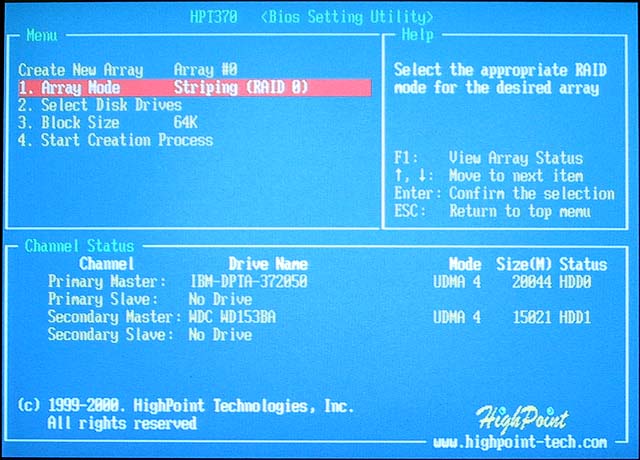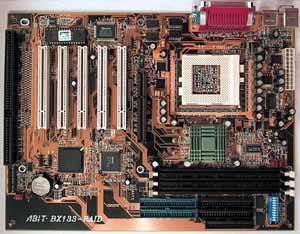ABIT BX133-RAID i440BX Socket-370 ATX
by Mike Andrawes on July 28, 2000 12:00 PM EST- Posted in
- Motherboards
It's been over two years since we first looked at an i440BX board from ABIT, the BX6 that will remain a fond memory to overclockers that owned it for a long time to come. There are still quite a few BX6's that are still chugging along today just fine, likely one of the few components that hasn't been upgraded by those living on the cutting edge of computer hardware technology. First delay's in Intel's i820 chipset, then the absurdly high price of RDRAM combined with its minimal performance improvement, if any at all, have allowed the i440BX chipset to live on much longer than originally planned. In an effort to bring the aging i440BX up to snuff with the latest chipsets from Intel and VIA in terms of specifications, motherboard manufacturers have added everything from on-board Ultra ATA/66 controllers to additional USB ports. Most importantly, they've been able to tweak their i440BX designs so that the 133 MHz FSB is stable as long as the graphics card can handle the overclocked AGP bus.
ABIT has faithfully stuck with the i440BX all along and is now on their ninth board based on the chipset. ABIT was one of the first manufacturers to enhance the i440BX by including a HighPoint Ultra ATA/66 controller on the BE6. The BP6 brought us the first dual processor Socket-370, introducing countless numbers of users to SMP and Windows NT. With the BE6-2 and BF6, they introduced SoftMenu III, allowing for FSB overclocking up to 200 MHz in 1 MHz increments. With BX boards decked out with just about every add-on you can think of and the recent release of the i815, we wondered if we had finally seen the last new BX board.
Apparently ABIT thinks the good ol' BX still has some life left in it and they've brought us the all new BX133-RAID. What more could you possibly add to a BX board? There's no way we're going to get a 1:2 AGP:FSB ratio to make the 133 MHz FSB run completely within spec because that's a function of the chipset. The same goes for AGP 4X support and Intel Hub Architecture (IHA, formerly Accelerated Hub Architecture or AHA).
So what exactly did they do then? Read on to find out...
|
Motherboard Specifications |
|
| CPU Interface |
Socket-370
|
| Chipset |
i440BX
HighPoint HPT370 Ultra ATA/100 RAID |
| Form Factor |
ATX
|
| Bus Speeds |
66
/ 75 / 83 - 200 in 1MHz steps
|
| Voltages Supported |
Auto
Detect
Adjustable to 1.3V - 3.5V |
| Memory Slots |
3 168-pin DIMM Slots
|
| Expansion Slots |
1 AGP Slot
5 PCI Slots (5 Full Length) 0 AMR/CNR Slots 1 ISA Slot |
| Onboard Sound |
N/A
|
| BIOS |
Award Modular BIOS 6.00PG
ABIT SoftMenu III |
The Good
While the BE6-2 and BF6 were evolutionary designs, based closely off their predecessor, the BX6, BH6, BX6 Revision 2.0, the BX133-RAID is definitely a bit of a departure for ABIT. Thanks to Intel's push towards the more cost conscious socketed CPU interface, ABIT's biggest departure from their old design is the inclusion of the Socket-370 in place of the Slot-1 interface all those previous ABIT BX boards have had. ABIT has actually done 2 previous BX Socket-370 boards, the BM6 and the BP6, but both of those boards are considerably different.
Nevertheless, there are still some similarities between the BX133-RAID and ABIT's previous BX boards. The relative positioning of the i443BX North Bridge, memory slots, and clock generator is borrowed for the BE6-2/BF6 as is the layout of the expansion slots, south bridge, and HighPoint controller. The North Bridge, memory slots, and clock generator are all moved forward about an inch to make room for the Socket-370 interface.
The other big change for ABIT is the substitution of the HPT370 controller in place of HighPoint's older HPT366 on older ABIT products. The HPT370 adds Ultra ATA/100 and, more importantly, RAID support in the same compact single chip package. Hard drive performance is by far one of the biggest bottle necks in today's systems, especially for typical everyday use such as most internet and business applications. The HPT370 supports striping (RAID 0), mirroring (RAID 1), and mirroring + striping (RAID 0+1). By buying a motherboard with an integrated RAID controller, you save quite a bit over buying a motherboard and than a separate RAID controller. ABIT has included Windows 98, 2000, and NT 4.0 drivers on their CD, while the HighPoint driver built into the latest Linux kernels should work as well.

The HPT366 has been known to have compatibility problems with certain devices, including CD-ROM's and even some hard drives. It's not yet clear whether all of these issues have been resolved with the HPT370, but your best bet is to search around the net to see if anyone has had any troubles with their BX133-RAID's and the particular devices you plan on having on the HPT370 channels. One benefit of having this controller onboard is that you still have the two Ultra ATA/33 channels courtesy of Intel's PIIX4e South Bridge, which can be used for all non-Ultra ATA 66/100 devices.











0 Comments
View All Comments